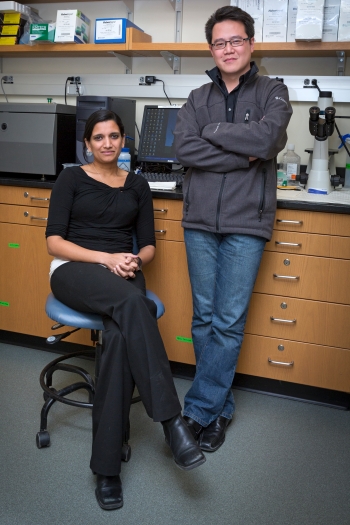
By
Boston College chemists have developed a nano-scale cage of chemical bonds that entraps small molecule drugs and then infiltrates cancer cells, showing promise it can serve as a “smart” drug delivery mechanism to fight cancer and other illnesses.
Assistant Professors of Chemistry Frank Tsung and Eranthie Weerapana developed the chemical framework, a so-called “nanosphere” cultivated with a combination of metal and organic materials. Laboratory tests showed the nanospheres effectively penetrated and killed breast cancer cells.
“We were very excited to see the results,” said Tsung. “We always want our solutions to work, but to see our organic-based drug delivery system attack and kill cancer cells in our lab tests was extremely gratifying. We know there is much work to be done, but we’re excited about the potential in this advance.”
In the quest to improve the work of drugs that fight cancer and other diseases, researchers have looked for ways to exploit the advantages of nanotechnology, in this case a nano-scale metal organic framework (MOF). These frameworks have proven useful in certain functions, but until now demonstrated instability in the body’s watery physiology, Tsung said.
So Tsung and Weerapana set out to create a framework that can effectively transport the drug through the body and deliver it to target cells. Efficiency is a crucial issue, as some drugs fail to fully penetrate cell membranes. Some drugs erode before they find their targets, requiring increased dosages, which are expensive and can produce unwanted side effects in patients.
Tsung and Weerapana’s nanosphere overcomes these significant challenges, the two faculty members reported in a recent edition of the American Chemical Society journal ACSNano.
Tsung and researchers in his lab were able to cultivate the nanospheres by creating organic links between tens of thousands of zinc ions, essentially creating a constellation of 800 tiny cage-like structures capable of entrapping small molecules. The overall size of these constellations must be large enough to transport proper dosage, yet small enough to penetrate the target cell membrane.
“That size between 50 and 100 nanometers is the magic number,” said Tsung. “If you have too small a framework, it won’t work. If we stay between 50 to 100 nanometers, it can penetrate the cancer cell. Our nanosphere is in the 70 nanometer range, which we think is ideal.”
Next, the researchers had to impart some control on the structure, so that it would release the drug dosage once it entered the cancer cell membrane. The team then utilized a unique property of the framework that would trigger drug release based on a drop in pH levels. While the body’s pH level is 7.4, the extracellular microenvironments of cancer cells generally have lower pH. Upon entering the cancer cell, the lower pH level triggers a chemical reaction that releases the drug, Tsung said.
“It is the body’s own mechanisms that trigger the release of the drug, which is a huge advantage,” Tsung said. “When the nanosphere enters the cancer cell, the lower pH level destabilizes the structure, which begins to break apart and releases the drug so it can begin to do its job of attacking and killing cancer cells.”
Tsung said their research showed that targeting could be improved by incorporating iron oxide into the structure and using an external magnetic field to direct the drug to the target cells.
He said the team’s next step is to functionalize the material with antibodies in order to use the body’s own immune response to draw the nanosphere to the disease cells. Tsung said the organic components in the nanosphere might make it easier to functionalize with an antibody.
Tsung said the nanosphere is non-toxic and that the team achieved the unique structure by carefully controlling temperature during fabrication. Furthermore, the structures were cultivated from low-cost, readily available materials that can help control costs.



